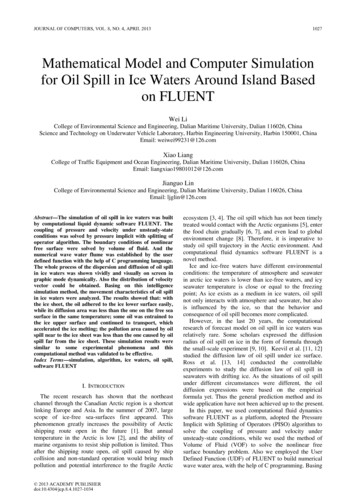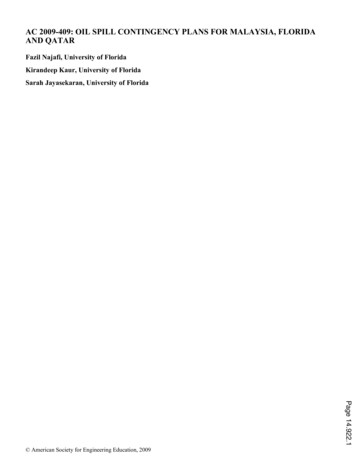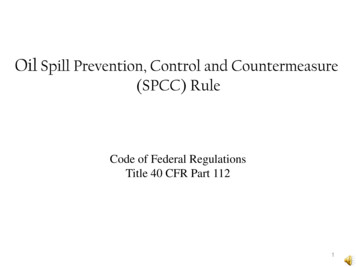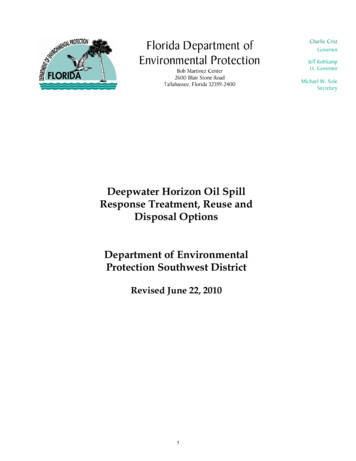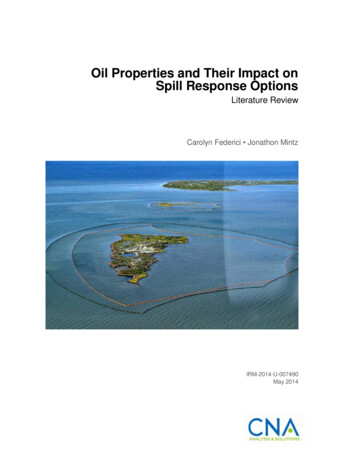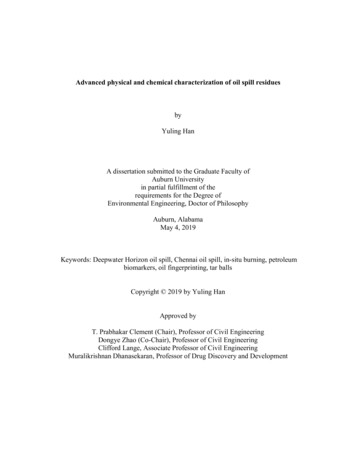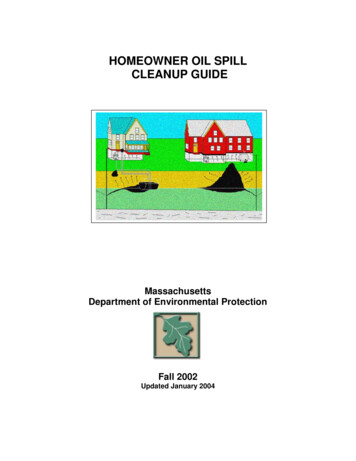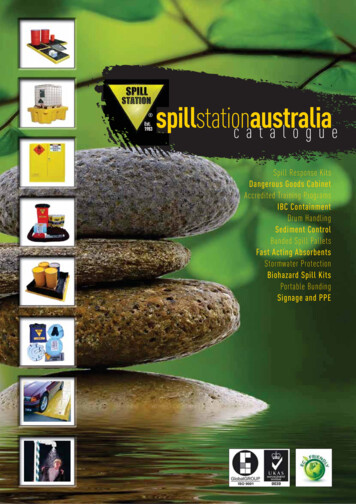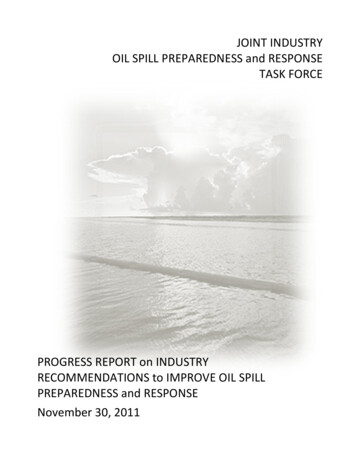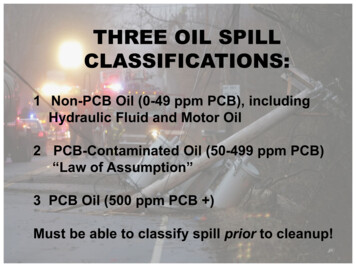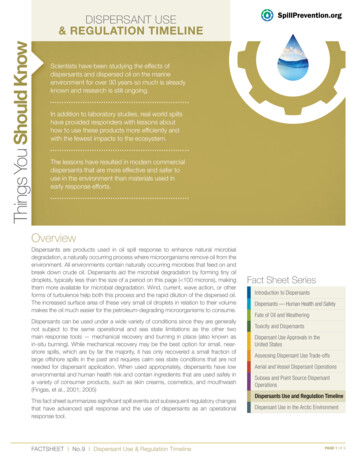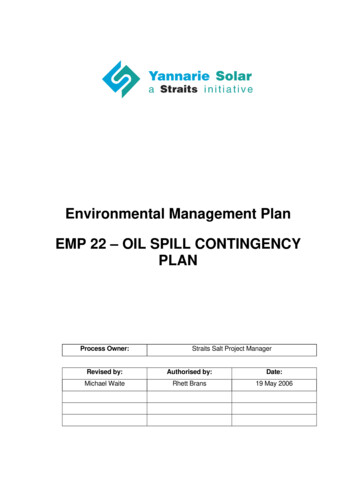
Transcription
Environmental Management PlanEMP 22 – OIL SPILL CONTINGENCYPLANProcess Owner:Straits Salt Project ManagerRevised by:Authorised by:Date:Michael WaiteRhett Brans19 May 2006
EMP 22 — Oil Spill Contingency PlanTable of Contents1OVERVIEW42. GENERAL PRINCIPLES43. PURPOSE OF THE PLAN54. FATE AND BEHAVIOUR OF SPILLED OIL75. COMBAT TECHNIQUES86. FREQUENCY AND TYPES OF OIL SPILLS FROM SHIPPING OPERATIONS117. LEGISLATIVE MECHANISMS AND INDUSTRY ARRANGEMENTS FORPROVISION OF OIL SPILL RESPONSE CAPABILITY128. STRAITS’ EMERGENCY RESPONSE PLAN (OSCP)129.0 OIL SPILL RESPONSE1810. PEOPLE, TRAINING AND EXERCISE PROGRAMS2011. SUMMARY2012. REFERENCES25Appendix AFlow Chart of EventsAppendix BContacts for Emergency EventsEMP 22 Oil Spill Contingency Plan V1.5 22 May 06Page 2
EMP 22 — Oil Spill Contingency PlanList of FiguresFigure 1: Exmouth Gulf with proposed 10Mtpa saltfieldFigure 2: Processes following a spillFigure 3: How dispersants workFigure 4: How oil is contributed to the oceanFigure 5: Yannarie Solar Project: shipping route, anchoring areas and barge route.Figure 6: Bathymetry of eastern coast of Exmouth GulfFigure 7: Tidal currents in the Gulf: Peak ebb (a), and 3 hours after peak ebb (b)Figure 8: Tidal currents in the Gulf: Peak flood (a), and 3 hours after peak flood (b)Figure 9: Time-series showing the predicted flushing of particles from Exmouth Gulfunder wind and tide-driven circulationFigure 10: Sea Surface Temperatures 13 March 2005EMP 22 Oil Spill Contingency Plan V1.5 22 May 06Page 3
EMP 22 — Oil Spill Contingency Plan1OVERVIEWIn the event that the Yannarie Solar proposal is approved by government, Straits willensure that they are well equipped and prepared to respond to any spills that occurwithin or in the vicinity of the Yannarie Solar proposal. Straits will maintain appropriateoil spill response equipment, with fully trained staff available at all times. In addition,Straits will obtain access to equipment stockpiled at ? as part of the National Plan.The National Plan holds a wide range of response equipment at all major ports.Equipment provided by the Australian Maritime Safety Authority (AMSA) is generallytargeted at larger spills (Tier 2 and 3). This is complemented by equipment held byport authorities for Tier 1 spills, individual oil and chemical companies and by theAustralian marine oil spill centre stockpile in Geelong (see Section 8. Straits’Emergency Response Plan (OSCP). Equipment can be rapidly deployed to the sceneof a spill. BHP’s petroleum operations offshore from the Cape at Stybarrow, Pyrenees,WA-255-p20 and the Griffin Venture, also have stockpiled assets and an oil spillcontingency plan for the Exmouth sub-basin.Industry’s safety record of handling oil and its products in Western Australia has beenexcellent and has been maintained throughout the last two decades of rapidlyincreasing volumes produced and transported in State and National waters. Oil spillshave been insignificant and, whilst there have been at least two significant spillsarising from shipping accidents, none has had a lasting impact on the marineenvironment.Nevertheless, Straits, is aware of a potential for a possible impact of oil spills on themarine environment and is committed to protect the ecosystems surrounding itsoperations.2. GENERAL PRINCIPLESOil Spill management will be an integral component of Straits overall environmentalmanagement program. Sound oil spill management practices will: minimise potential to cause harm to human health or the environment; conserve resources, including minimisation of costs through the reductionof response and clean up costs; and ensure continued regulatory and public confidence in the Company.Oil Spill management will involve two key elements: spill prevention – as a first priority; and emergency and oil spill responseOil spill prevention will be maximised by: sound design and engineering practice; sound construction, operating and maintenance procedures; and a high level of environmental awareness and training.EMP 22 Oil Spill Contingency Plan V1.5 22 May 06Page 4
EMP 22 — Oil Spill Contingency PlanA high level of oil spill response preparedness is also important. Oil spill responsepriorities are to: protect human life and property; shut off the source of the oil spillage; prevent oil contact on shorelines or sensitive marine and coastalresources; recover any free oil, where practicable; rehabilitate any affected shoreline and or marine life; monitor impacts and recovery; review oil spill management procedures; implement corrective action programs as necessary;3. PURPOSE OF THE PLANThis Plan defines the role of Straits in response to oil spills eliminating from or directlyassociated with the Yannarie Solar operations (see Figure 1). It has the intention ofincreasing the understanding of the complex but orderly activity of an oil spill responseby defining the roles and activities of key Straits operatives and specifying keyobjectives and conservation priorities.EMP 22 Oil Spill Contingency Plan V1.5 22 May 06Page 5
EMP 22 — Oil Spill Contingency PlanFigure 1: Exmouth Gulf with Proposed 10Mtpa Salt FieldEMP 22 Oil Spill Contingency Plan V1.5 22 May 06Page 6
EMP 22 — Oil Spill Contingency Plan4. FATE AND BEHAVIOUR OF SPILLED OILOil or fuel can harm the marine environment by smothering marine life or acting as atoxin to both marine and coastal flora and fauna. It can also bio-accumulate inorganisms and thus affect organisms higher in the food chain. Sea animals and birdscan be harmed when their feathers or fur are coated with oil. Chemical contaminantswithin the oil can also impair reproduction for sea animals and birds.4.1Oil movementWhen oil is spilled onto the surface of the sea it spreads very rapidly, and after a fewhours the slick will usually also begin to break up and form narrow bands or"windrows" parallel to the wind direction. Within a very short time, therefore, the oil willoften be scattered within an area of many square miles with large variations in oilthickness being evident. This is one of the fundamental factors that limits theeffectiveness of all at-sea response techniques.Whilst computer models can be used to calculate the probable movement andspreading of spilled oil, experience shows that it is unwise to place total reliance onsuch predictions. Inadequate knowledge of surface currents in the area of the spill,local wind variations and the unpredictable behaviour of some oils (e.g. submergenceof heavy oils in rough seas or low salinity waters due to neutral buoyancy) are amongthe factors that can cause spilled oil to move in surprising directions. This is why aerialsurveillance by experienced observers, possibly supplemented by remote sensingequipment if available, is an essential element of an effective response. Surveillanceflights should be undertaken at the outset of an incident and then on a regular basisthereafter to confirm the location and extent of the pollution and to verify and updatepredictions on the oil’s probable movement and the threat it poses to sensitiveresources. It is important to co-ordinate flights and flight plans to avoid duplication,and to prevent unnecessary disturbance of colonies of seabirds and marinemammals, which might otherwise be frightened into diving into nearby floating oil.4.2WeatheringAt the same time as the oil spreads, moves and fragments it also undergoes anumber of physical and chemical changes, collectively termed weathering. Most ofthese weathering processes, such as evaporation, dispersion, dissolution andsedimentation, lead to the disappearance of oil from the sea surface. On the otherhand, the formation of water-in-oil emulsion (“mousse”) and the accompanyingincrease in viscosity as the oil absorbs up to four times its own volume of water,promote the oil’s persistence. Ultimately, the marine environment assimilates spilt oilthrough the long-term process of biodegradation.The speed and relative importance of the processes depends on factors such as thequantity and type of oil, the prevailing weather and sea conditions, and whether or notthe oil remains at sea or is washed ashore.EMP 22 Oil Spill Contingency Plan V1.5 22 May 06Page 7
EMP 22 — Oil Spill Contingency Plan4.3Type of oilOne of the most significant factors in any spill is the type of oil, especially its probablepersistence in the marine environment.In general, non-persistent oils include light refined products (e.g. gasoline) and evensome light crude oils which are highly volatile materials with low viscosities. As theydo not normally persist on the sea surface for any significant time due to rapidevaporation and the ease with which they disperse and dissipate naturally there isusually only a limited requirement for cleanup. Such oils may, however, pose asignificant fire and explosion hazard as well as cause public health concerns if theyoccur close to centres of population. They may also cause significant environmentalimpacts due to their high concentration of toxic components but, as these samecomponents evaporate rapidly, any such effects will usually be highly localised.At the other end of the spectrum of oil types are heavy crudes and heavy fuel oils.These oils are highly persistent when spilled due to their greater proportion of nonvolatile components and high viscosity. Such oils have the potential, therefore, totravel great distances from the original spill location, causing widespreadcontamination of coastlines and damage to amenity areas, fishing gear and wildlife,mainly through physical smothering. As a consequence, the cleanup of heavy oil spillscan be extremely difficult, extend over large areas and be costly. The problem ofdealing with heavy oils is also the reason why bunker spills from non-tankers canoften cause problems that are far greater than might be suggested by the amount ofoil spilled.Between the two extremes of gasoline and heavy fuel oil there are many intermediatecrude oils and refined products that are transported by tankers and used in a varietyof marine engines. It is therefore important when a spill occurs to know the exact typeof oil involved and its characteristics. This can sometimes be difficult to determine withcertainty during the early stages of a spill, leading to confusion and unreliablepredictions.5. COMBAT TECHNIQUESThe processes that follow an oil spill are illustrated in Figure 2.No two oil spills are the same because of the variation in oil types, locations andweather conditions involved. However, broadly speaking, there are four main methodsof response.1. Leave the oil alone so that it breaks down by natural means.2. Contain the spill with booms and collect it from the water surface usingskimmer equipment.3. Use dispersants to break up the oil and speed its natural biodegradation (notto be used in the case of Yannarie Solar).4. Introduce biological agents to the spill to hasten biodegradation.Often the response involves a combination of all these approaches.EMP 22 Oil Spill Contingency Plan V1.5 22 May 06Page 8
EMP 22 — Oil Spill Contingency PlanFigure 2. Processes following a spill5.1Natural dispersionIf there is no possibility of the oil polluting coastal regions or marine industries, thebest method is to leave it to disperse by natural means. A combination of wind, sun,current and wave action will rapidly disperse and evaporate most oils. Light oils willdisperse more quickly than heavy oils.5.2Booms and skimmersSpilt oil floats on water and initially forms a slick that is a few millimetres thick. Thereare various types of booms that can be used either to surround and isolate a slick, orto block the passage of a slick to vulnerable areas such as mangrove fish breedinggrounds or other sensitive locations.Boom types vary from inflatable neoprene tubes to solid, but buoyant material. Mostrise up about a metre above the water line. Some are designed to sit flush on tidalflats while others are applicable to deeper water and have skirts which hang downabout a metre below the waterline.Skimmers float across the top of the slick contained within the boom and suck orscoop the oil into storage tanks on nearby vessels or on the shore.However, booms and skimmers are less effective when deployed in high winds andhigh seas.EMP 22 Oil Spill Contingency Plan V1.5 22 May 06Page 9
EMP 22 — Oil Spill Contingency Plan5.3DispersantsThese act by reducing the surface tension that stops oil and water from mixing. Smalldroplets of oil are then formed which helps promote rapid dilution of the oil by watermovements. The formation of droplets also increases the oil surface area, thusincreasing the exposure to natural evaporation and bacterial action.Dispersants are most effective when used within an hour or two of the initial spill.However they are not appropriate for all oils and all locations. Successful dispersion ofoil through the water column can affect marine organisms like deep water corals andseagrass. It can also cause oil to be temporarily accumulated by sub-tidal sea life.Decisions on whether or not to use dispersants to combat an oil spill must be made ineach individual case. The decision will take into account the time since the spill, theweather conditions, the particular environment involved and the type of oil that hasbeen spilt. Note that some dispersants are potentially toxic in themselves.5.3.1How Dispersants workFigure 3 illustrates how dispersants aid in natural biodegradation ofhydrocarbons.Figure 3. How dispersants workEMP 22 Oil Spill Contingency Plan V1.5 22 May 06Page 10
EMP 22 — Oil Spill Contingency Plan5.4BioremediationMost of the components of oil washed up along a shoreline can be broken down bybacteria and other micro-organisms into harmless substances such as fatty acids andcarbon dioxide. This action is called biodegradation. The natural process can bespeed up by the addition of fertilising nutrients like nitrogen and phosphorous whichstimulate growth of the micro-organisms concerned.However, the effectiveness of this technique depends on factors such as whether theground treated has sand or pebbles and whether the fertiliser is water soluble orapplied in pellet or liquid form.6. FREQUENCY AND TYPES OF OIL SPILLS FROM SHIPPINGOPERATIONSFigure 4 illustrates the proportion that various contributors have to oil in the ocean.Historically, and by far, the highest contributor to oil in the ocean (about 37%) hasresulted from a mixture of wastes discharged from land and reaching the marineenvironment via storm water drains, outfalls, creeks and rivers. 7% of oil in the seaseeps naturally out of fissures in the sea bed. 14% of oil spills come from spills duringthe exploration and production phase, by oil industry rigs and platforms and fromaccidents involving oil tankers. 33% occur during the operation of vessels other thanthose used by the oil industry, which may be involved in collisions, fuel spill duringtransfer or discharge oil from ballast tanks during a voyage. The remaining 9% of oil inthe oceans is absorbed from the atmosphere (source: Australian Institute ofPetroleum, 1996).Naturalsources7%Explorationand production2%Atmosphere9%Industrialdischarge andurban re 4. How oil is contributed to the ocean.EMP 22 Oil Spill Contingency Plan V1.5 22 May 06Page 11
EMP 22 — Oil Spill Contingency Plan7. LEGISLATIVE MECHANISMS AND INDUSTRY ARRANGEMENTS FORPROVISION OF OIL SPILL RESPONSE CAPABILITYOil spill response capability is legislated at national, state and local levels. TheAustralian Maritime Safety Authority (AMSA) administers the National Plan to CombatPollution of the Sea by Oil and other Noxious and Hazardous Substances (theNational Plan - NATPLAN). AMSA is the agency responsible for response to oil spillsand other marine pollution in Commonwealth waters. Government responses areaugmented by industry arrangements, such as the Australian Institute of Petroleum’s(AIP) Marine Oil Spill action Plan (MOSAP) and the upstream petroleum industry’snational equipment and materials stockpile and resource centre in Geelong, Victoria,known as the Australian Marine Oil Spill Centre (AMOSC).West Plan – Marine Oil Pollution (WestPlan – MOP)) applies to all spills of oil in WAwaters, within ports and on shorelines. WestPlan – MOP has been prepared inaccordance with the Pollution of Waters by Oil and Noxious Substances Act 1987.This Act implements MARPOL 73/78 (International Convention for the Prevention ofPollution from Ships, 1973, as modified by the Protocol of 1978) and details theliabilities and penalties for discharges from ships and enables WA to take measures torespond to spills. WestPlan – MOP operates within NATPLAN. Various organisationshave roles under the WestPlan MOP. These include the WA Department of Planningand Infrastructure (DPI), Australian Maritime Safety Authority (AMSA), Department ofIndustry and Resources (DOIR), Department of Environment (DOE), Fire andEmergency Services Authority (FESA), Department of Conservation and LandManagement (CALM), Department of Fisheries and Port Authorities.8. STRAITS’ EMERGENCY RESPONSE PLAN (OSCP)Straits will be prepared to respond to oil spills within the Straits Yannarie Solaroperation, or originating from the project facilities. The objective of the Straits Oil SpillContingency Plan (OSCP) is to minimise the impact of incidents potentially harmful topeople, property and environment. The OSCP specifically addresses thepreparedness, response capability and recovery plans for potential incidents, within orimpacting on, the Straits Yannarie Solar operation.Both MOSAP and NATPLAN are regionalised plans. Hence arrangements for Straits’area of operations will be established in conjunction with the WA branch of the AIP,AMSA and AMOSC.In Australia, a tiered response concept based on international practice is used by allGovernment and industry authorities, with Tier 1 – up to 10 tonnes of oil, Tier 2 – upto 1000 tonnes and Tier 3 - 1000 tonnes and above. Straits’ contingency plan willmanage all Tier 1 spills and lower Tier 2 spills involving an estimated oil quantity ofbetween 10 and 100 tonnes. Local NATPLAN and MOSAP teams will be called in toprovide assistance for any spill if necessary.EMP 22 Oil Spill Contingency Plan V1.5 22 May 06Page 12
EMP 22 — Oil Spill Contingency Plan8.1 ContentsThe Straits Oil Spill Contingency Plan will be detailed in a manual which will include(as required): relevant safety information and safety priorities such as:-personnel safety;-fire prevention; and-shutting off the source of the spill.relevant environmental sensitivity information and priority protection areassuch as:-meteorological and oceanographic conditions;-marine and coastal habitats;-shoreline types;-marine and coastal fauna;-ecological processes (eg migration, breeding seasons etc); and-human uses.relevant oil spill movement/trajectory and fate information such as:-oil characteristics (evaporation, weathering rates, emulsification tendenciesand pour point) for each likely oil source (eg bunker oil and diesel); and-predicted trajectory paths and beaching times based on met ocean dataand forecasts (using computer modeling or manual means).Note:- An ability for computer modeling is only required in circumstances wherethe ‘risk’ of unacceptable environmental harm from an oil spill exceeds“moderate”.relevant response, cleanup and rehabilitation options and strategies such as:-offshore surveillance and monitoring;-offshore dispersal application in deep waters (NB with appropriateGovernment approvals);-booming to prevent oil entering sensitive areas;-skimming and recovery;-shoreline flushing and washing;-application of nutrients and/or oil-degrading bacteria on shorelines; and-environmental monitoring requirements.disposal strategies such as:-authorised land disposal;-oil recovery and recycling;EMP 22 Oil Spill Contingency Plan V1.5 22 May 06Page 13
EMP 22 — Oil Spill Contingency Plan incineration.tasks or actions that need to be carried out in the event of an oil spill such as:-stopping the spill;-reporting the spill to company management and regulatory authorities;-assessing the spill (eg size, type, direction of movement);-organising surveillance aircraft and/or vessels if spill is threatening facilitiesor heading for sensitive environments;-assessing anticipated movement of the slick (using weather forecasting,models, etc); and-organising placement of booms and deployment of other equipment andpersonnel.roles, responsibilities and authorities for ensuring the tasks are carried out,such as:-person in charge of response activities (Response Coordinator/ TeamLeader);-person/teams responsible for mobilising equipment and personnel;-person/teams responsible for Government and external liaison;-person/teams responsible for scientific support (eg monitoring programs,impact assessment); and-person/teams responsible for recording events.inventory lists of facilities, equipment and materials (including location andmobilisation time) available for use such as (in no particular priority order):-dispersants;-booms;-skimmers;-absorbent materials;-storage tanks;-aircraft;-vessels;-helicopter underslung dispersant buckets;-oil spill waste disposal sites;-oil recyclers.resources and external emergency services such as the Australian MaritimeSafety Authority (AMSA) National Plan to Combat Pollution of the Sea by Oiland other Noxious and Hazardous Substances (NATPLAN), The upstreamindustry national equipment and materials stockpile and resource centre inGeelong, Victoria, known as the Australian Marine Oil Spill Centre (AMOSC),West Plan – MOP, MARPOL 73/78, Australian Institute of Petroleum’s (AIP)Marine Oil Spill Action Plan (MOSAP):-telephone and radio communications systems;EMP 22 Oil Spill Contingency Plan V1.5 22 May 06Page 14
EMP 22 — Oil Spill Contingency Plan8.28.3-initiating callout of personnel and resources (both company and external);and-contact lists for personnel, external emergency services, resources andequipment suppliers, Government and specialist assistance groups (egvolunteer wildlife rehabilitation groups.Description of Areas Where Spills are Most Likely to Occur fuel transfer from barge to shore storage tank failure fuel piping failure fuel transfer barge collision salt transport shipping collisionPotential Spills – PredictionA computer-based Oil Spill Trajectory Model (OSTM) is used to simulate andpredict the movement of oil spills. The information provided assists thosemaking decisions on measures needed to counter the threat to the marineenvironment. An OSTM capability is provided by AMSA under the NationalPlan, except where a particular operation or facility has a high’ risk of asignificant (in terms of volume and/or potential for significant impact) spill.The National Plan Oil Spill Response Atlas (OSRA) is a computer-baseddigital mapping system that allows operators to overlay various types of datato identify biological, cultural, geomorphological and socio-economic resourcesand how a marine pollution incident may impact these resources.To assist in predicting, modelling and preventing chemical spills, the NationalPlan also has access to a range of chemical spill and emergency decisionsupport tools. These tools provide information on bulk chemicals andpackaged goods transported by sea, chemical toxicity and properties,atmospheric plume dispersion and safety emergency procedures.The project shipping route, anchorage areas and barge routes for the StraitsYannarie Solar project are detailed at Figure 5 (page 21).As part of the ERMP process, Straits also have other significant technical andmodeled information, which would be useful in an oil spill trajectory and impactmodeling scenario. This information includes: bathymetry of the Exmouth Gulf(Figure 6, page22); tidal currents in the Exmouth Gulf (Figure 7 and Figure 8,page 23); time series showing predicted flushing of particles from ExmouthGulf under wind and tide-driven circulation (Figure 9, page 24); and seasurface temperatures (Figure 10 , page 24).EMP 22 Oil Spill Contingency Plan V1.5 22 May 06Page 15
EMP 22 — Oil Spill Contingency PlanPotential oil spill scenarios include:8.4 Release of full tank of fuel oil (bunker oil) in case of transport eaofpotentialimpact—environmental implications/risk Release of barge contents in case of transport barge collision –50,000 litres/diesel – area of potential impact – environmentalimplications/risk Fuel transfer to shore – diesel – area of potential impact – environmentalimplications/risk Storage tank – complete failure of all tanks - risk is minimal and bunddesigned to contain the volume of the more likely (but still low) scenario ofa failure of one tank – area of potential impact – environmentalimplications/riskSpill Emergency Contacts Australian Maritime Safety Authority (AMSA)See attachment (Appendix B) Department of Consumer and Employment Protection (DOCEP)Have taken over the responsibilities of the Department of Industry andResources (DOIR)Richard CraddockDirector Petroleum and Major Hazard Facilities Safety BranchEmergency Incident Reports 1300 655 500Phone: 61 8 9222 3254 Fax: 61 8 9222 3525Email:rcraddock@docep.wa.gov.auDepartment of Environment (DoE)Ken RaineManager, Pollution ResponseEmergency Pollution Reports: 1800 018 800Phone: 61 8 9222 7123Email:ken.raine@environment.wa.gov.auEMP 22 Oil Spill Contingency Plan V1.5 22 May 06Page 16
EMP 22 — Oil Spill Contingency Plan Fire and Emergency Services Authority (FESA)Frances CasellaManager State Emergency Management CapabilityPhone: 61 8 9323 9810 Fax: 61 8 9323 9462Email:fcasella@fesa.wa.gov.auDepartment of Conservation and Land Management (CALM)District Office22 Nimitz StreetPO Box 201EXMOUTH WA 6707 Tel: 61 8 9949 1676Fax: 61 8 9949 1580FisheriesExmouth District OfficeCnr Payne and Riggs StExmouth WA 6707Phone: 61 8 9949 2755Fax: 61 8 9949 1558Shire of Exmouth22 Maidstone Crescent (PO Box 21)Exmouth WA 6707Phone: 61 8 9949 1399Fax: 61 8 9949 1277Email:shirex@exmouth.wa.gov.auEMP 22 Oil Spill Contingency Plan V1.5 22 May 06Page 17
EMP 22 — Oil Spill Contingency Plan8.5Information for Spill Response Departments Location of spill Source of spill Time of spill Estimated volume of spill Nature and potential danger of spilled material Anticipated movement of spilled material Action already taken Weather conditions at spill siteUpon discovering a spill, Straits employees will make every effort to stop the source ofthe spill and contain the spilled materials. If any danger to the health and/or safety toemployees exist from the spill, only those methods which would allow for minimumcontact with the spill site area will be undertaken. Clean-up and removal of the spillwill also be undertaken, as soon as possible.9.0 OIL SPILL RESPONSE9.1Containment equipment on siteThe National Plan holds a wide range of response equipment at all major ports.Equipment provided by AMSA is generally targeted at larger spills (Tier 2 and 3). Thisis complemented by equipment held by port authorities for Tier 1 spills, individual oiland chemical companies and by the Australian Marine Oil Spill Centre stockpile inGeelong. Equipment can be rapidly deployed to the scene of a spill.Types of equipment include oil spill control booms of varying types and sizes, selfpropelled oil recovery vessels, static oil recovery devices and sorbents. A range ofstorage devices including free standing tanks and towable storage bladders and bagscomplement recovery devices.Equipment used for chemical spills depends on the type of chemical. Chemicalsubstances have properties that vary widely and can damage or cause failure to sometypes of equipment. Appropriate chemical response and clean up equipment isidentified by the chemical industry and fire authorities. Suitable oil responseequipment may be used in a chemical spill.In the event that the Yannarie Solar proposal is approved by government, Straits willensure that they are well equipped and prepared to respond to any spills that occurwithin or in the vicinity of the Yannarie Solar Project. Straits will maintain appropriateoil spill response equipment, with fully trained staff available at all times. Straits willprovide, on site (as required):EMP 22 Oil Spill Contingency Plan V1.5 22 May 06Page 18
EMP 22 — Oil Spill Contingency Plan Booms large enough to contain the volume of the largest predicted spillpotential Skimmers Pillows (number) Pads (number) Gloves Goggles Coveralls Hazardous material disposal bags9.2Controls An Oil Spill Contingency Plan for dealing with potential oil spills from a collisionin the Gulf Staff trained in response procedures Equipment available for containment, efficient recovery and clean-up ifrequired Containment and diversionary structures and equipment on-site to preventspills from reaching open water9.3Inspections Automatic fuel cut off devices will be installed on fuel transfer hoses.Equipment and hoses will be inspected regularly Barges will be tested annually for leaks and overall soundness Tanks will be tested annually for leaks and overall soundness – shell thicknesswill be tested every other year Tank inventories will be taken daily Above ground piping will be visually inspected weekly and logs kept ofinspections Valves, gaskets, flanges will be inspected weekly and monitored for leaksand/or stains and logs kept to record this Bunded areas will be monitored daily. Accumulated water will be inspected foroil sheen. Areas will drained, recording date, time and approximate quantitydischarged, noting no oily discharge released. Appropriate sumps and oil –water separators will be utilized. Spill response equipment will be inventoried monthly or after use and inventoryreplaced immediatelyEMP 22 Oil Spill Contingency Plan V1.5 22 May 06Page 19
EMP 22 — Oil Spill Contingency Plan10. PEOPLE, TRAINING AND EXERCISE
EMP 22 — Oil Spill Contingency Plan EMP 22 Oil Spill Contingency Plan V1.5_22 May 06 Page 2 Table of Contents 1 OVERVIEW 4 2. GENERAL PRINCIPLES 4 3. PURPOSE OF THE PLAN 5 4. FATE AND BEHAVIOUR OF SPILLED OIL 7 5. COMBAT TECHNIQUES 8 6. FREQUENCY AND TYPES OF OIL SPILLS FROM SHIPPING OPERATIONS 11 7.
